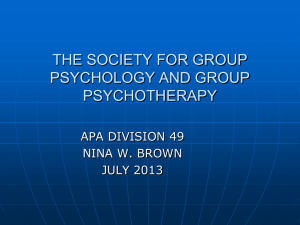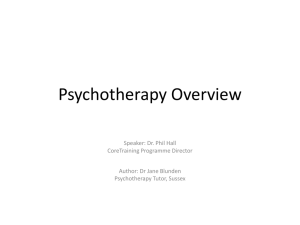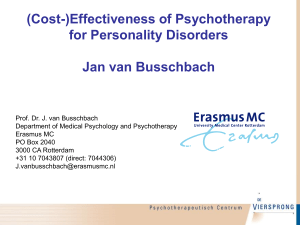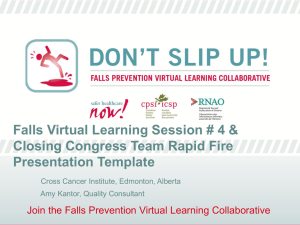From high dependency to self-responsibility - BIGSPD
advertisement
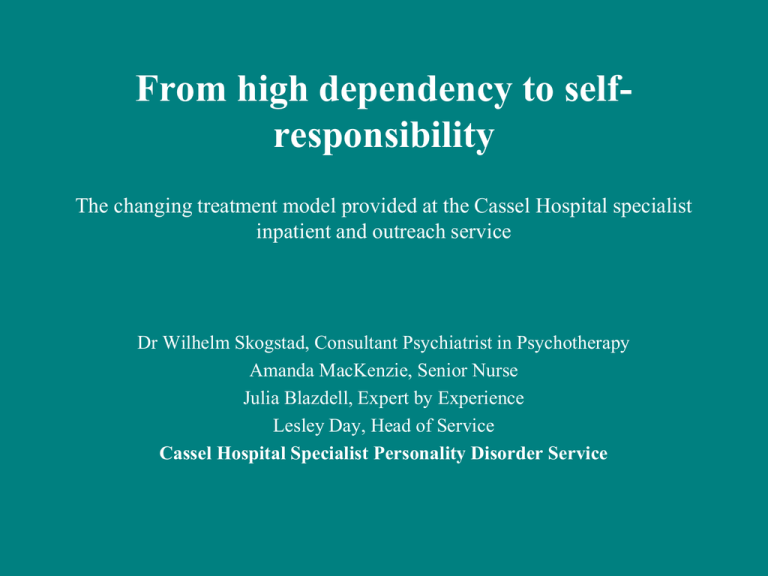
From high dependency to selfresponsibility The changing treatment model provided at the Cassel Hospital specialist inpatient and outreach service Dr Wilhelm Skogstad, Consultant Psychiatrist in Psychotherapy Amanda MacKenzie, Senior Nurse Julia Blazdell, Expert by Experience Lesley Day, Head of Service Cassel Hospital Specialist Personality Disorder Service Cassel Hospital Specialist Personality Disorder Service Psychotherapeutic and psychosocial inpatient, day patient and outpatient treatment for people with severe personality disorders and complex needs The Cassel - traditional and … The Cassel - … modern Traditional Model (1) Inpatient Treatment Traditional Model (2) Therapeutic Community Individual Psychotherapy Intermediate Model Inpatient Treatment Step-down Inpatient Treatment. Inpatient Treatment 6 months 12 months Outreach Treatment 24 months Cassel Research (M Chiesa et al) • One stage programme – 12 months inpatient treatment at the Cassel – No follow-up treatment from the Cassel • Step-down programme – 6 months inpatient treatment at the Cassel – 2 years outreach treatment: 2/wk group psychotherapy + psychosocial outreach nursing + working with local services • Treatment as usual – General psychiatric care and management,with hospital admissions, community support, psychotropic medication etc. Change in number of symptoms 75 70 65 m 60 e a n 55 Inpatient Step down TAU 50 45 40 Intake 6 mo 12 mo 24 mo 72 mo Change in symptom severity 2.2 2 1.8 m 1.6 e a n 1.4 Inpatient Step down TAU 1.2 1 0.8 Intake 6 mo 12 mo 24 mo 36 mo 72 mo Chiesa et al. (2006). Six-year follow-up of three treatment programs to personality disorder Journal of Personality Disorders, 25, 493-509. Changes in global functioning 62 58 m e a n 54 Inpatient Step down TAU 50 46 42 Intake 6 mo 12 mo 24 mo 36 mo 72 mo Change in social adaptation 3 Inpatient Step down 2.8 TAU 2.6 m e 2.4 a n 2.2 2 1.8 Intake 6 mo 12 mo 24 mo 36 mo 72 mo Parasuicidal Behaviour 62 Inpatient 52 Step down TAU 42 % 32 22 12 2 -1 o 2t 0 o m 2 0 -1 o m -2 4 2 1 o m -3 6 4 2 o m -7 2 0 6 Hospitalisation Inpatient Step down TAU 60 50 40 % 30 20 10 0 o0 t -12 -2 12 o m 4 -3 24 o m 6 -7 60 o m 2 Work on patients’ transitions • Joint work with professionals and patient towards admission • Written information for patients • Pre-admission day visits to the Cassel • Pre-admission planning meetings • Buddy system for new patients • Special structures for new patients • Long anticipation of leaving • Transition phase with shorter weeks or as day patient • Working towards discharge with patient and local service • Consulting to local professionals • Setting up treatment and support for after discharge Working with local services • • • • • • • • • Liaison with local professionals prior to referral Working jointly with professionals and patient towards admission Pre-admission planning meetings Treatment reviews CPA meetings Frequent contact with local professionals to update and discuss Joint work towards discharge back to local services Pre-discharge planning meetings Follow-up meetings with patient and/or professionals Pathways through the Cassel Intensive Community care Revolving door NHS or Private Sector NHS or Private Sector Low/Medium Secure Unit Acute Unit Psychosocial Assessment at the Cassel Residential treatment at the Cassel Joint work by Cassel and local services Transitional phase e.g. shorter weeks, day patient - involving local services Cassel Outreach in cooperation with local services Outpatient treatment through local services Cassel Multidisciplinary Team Consultant Psychiatrist, Psychoanalyst Dance Movement Therapist Psychosocial Nurses Multi Disciplinary Team Community Doctor Social Worker (SHO) SpRs Psychotherapy Psychotherapists Adult and Adolescent New Treatment Model Psychosocial Practice Psychotherapy MDT staff meetings. Community meetings Work Groups Physical and Social Activities Special Interest Groups Parents Group Psychosocial Education Community Management Meeting Planning meetings Reviews CPA/ Professionals Reflective practice Supervision Groups Individual psychotherapy Group Psychotherapy Dance Movement Therapy Couples/ Family sessions Why specialist residential treatment? • • • • • • • Significant risk (self-harm, suicide) - not manageable as outpatient Long hospital admissions with failure to discharge/revolving door Step-down from more secure setting Local treatment resources exhausted Change only possible through intensive treatment No local specialist treatment available Treatment only possible away from home Current Model Shared living-learning Environment IN CAMHS, CMHT/ Family/Carers/ Friends/ Psychiatric Forensic Services (wards) Psychosocial Practice ‘Alongside’ rather than ‘for’ the patient Psychotherapy MDT staff meetings. Community meetings Work Groups Physical and Social Activities Special Interest Groups Parents Group Psychosocial Education Community Management Meeting Planning meetings Reviews CPA/ Professionals Reflective practice Supervision Groups Family/carers/ friends, Voluntary sector, CMHT, Outreach OUT Individual psychotherapy Group Psychotherapy Dance Movement Therapy Couples/ Family sessions The process of change • • • • • • Relationships as central focus Helping develop an internal container through an external container Linking ‘understanding’ and ‘doing’ Fostering responsibility for themselves and others Enabling supportive relationships between patients Dealing with self-harm in a holistic way: challenging + understanding and support + emphasis on relationships (impact on others) • Taking measured risks: tolerating anxiety • Team work: bringing split-off aspects together in the staff team References • • • • • • • • • Chiesa, M. (2000) Hospital adjustment in personality disorder patients admitted to a therapeutic community milieu. British Journal of Medical Psychology 73: 259-267. Chiesa, M., Fonagy, P., Holmes, J. & Drahorad, C. (2004) Residential versus community treatment of personality disorders; a comparative study of three treatment programs. American Journal of Psychiatry, 161(8), pp 1463-1470. Chiesa, M., Fonagy, P. & Holmes, J. (2006) Six-year follow-up of three treatment programs to personality disorder. Journal of Personality Disorders, 20(5), pp 493-509. Chiesa, M. & Healy, K. (2009) The struggle to establish a research culture in the psychotherapy hospital: Reflections from the Cassel Hospital experience. Bulletin of the Menninger Clinic 73, 3: 157-175. Day. L. & Flynn, D. (Eds) (2003) The internal and external worlds of children and adolescents; collaborative therapeutic care (Cassel Hospital Monograph Series No. 3 ) London: Karnac Drahorad, C (1999) Reflections on being a patient in a therapeutic community. Therapeutic Communities, 20, 3: 195-215. Griffiths, P. & Pringle, P. (Eds) (1997) Psychosocial practice within a psychosocial setting (Cassel Hospital Monograph Series No. 1), Karnac Books, London Hinshelwood, R. D. & Skogstad, W. (1998) The hospital in mind; the setting and the internal world. In: Pestalozzi, J. et al. (Eds) Psychoanalytic psychotherapy in institutional settings, London: Karnac pp 59-73. Skogstad, W. (2003) Internal and external reality in in-patient psychotherapy; working with severely disturbed patients at the Cassel Hospital. Psychoanalytic Psychotherapy, 17 (2), pp 97-118.

